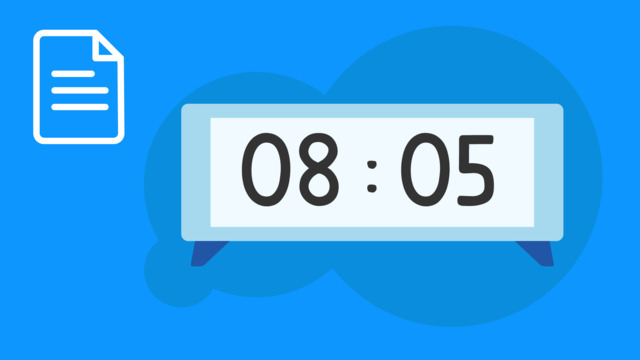Reading Digital Clocks
Learning text on the topic Reading Digital Clocks
Exploring Digital Clocks
In this text, we will learn about digital clocks and how to solve word problems involving time intervals using digital clocks. We will practise reading digital clocks and solving addition and subtraction problems with time intervals. Let's get started!
A digital clock is a type of clock that displays the time using numbers. It shows the hours and minutes in a clear and easy-to-read format. Each digit on a digital clock represents a specific value. The first two digits represent the hours, and the last two digits represent the minutes.
Reading Digital Clocks – Examples
Let’s go through the steps to telling the time on a digital clock. This is to get a better understanding of how digital clocks work.
To read a digital clock, we start by looking at the first two digits. These digits tell us the hours. Then, we look at the last two digits to determine the minutes.
To read the time on a digital clock, follow these steps:
| Step | What to do | It tells you |
|---|---|---|
| 1. | Look at the hour number - the first two digits - displayed on the clock. | This tells you the current hour. |
| 2. | Look at the minute number - the last two digits - displayed on the clock. | This tells you the current minute. |
| 3. | Combine the hour and minute numbers to read the time. | For example, if the hour is 3 and the minute is 30, the time is 3:30. |
Remember, the hour numbers go from 1 to 12, and the minute numbers go from 00 to 59. AM and PM are used to indicate if the time is before or after midday. AM stands for ante meridiem, which means before midday. PM stands for post meridiem, which means after midday.
Let's look at an example:
In this example, the first two digits are 08, which means it is 8 o'clock. The last two digits are 05, which means it is 5 minutes past the hour. So, the time shown on the digital clock is 8:05. We can also say it is five past eight.
Adding of Time Intervals
When we add time intervals, we are finding the total amount of time when two or more intervals are combined. Let's look at an example:
In this example, we start at 3:15 PM and end at 4:30 PM. To find the total time, we count the number of minutes between the two times on the number line diagram. In this case, it is 75 minutes. So, John played basketball for 75 minutes.
We count the duration, from the start time, to the next full hour. And then count to the end time. In this example, we count from 3:15 PM to 4:00 PM, that’s 45 minutes. From 4PM we count to 4:30 PM. That will be another 30 minutes. Add the two durations and you will get 75 minutes or 1 hour and 15 minutes.
Let’s look at another example together.
In this example, we start at 7:45 PM and end at 9:10 PM. To find the reading time, we count the number of minutes between the two times on the number line diagram. In this case, it is 85 minutes. So, Lisa read for 85 minutes or 1 hour 25 minutes.
Digital Clocks – Practice Exercises
Now it's time to practise what we've learnt! Try solving the following word problems:
Digital Clocks – History and Evolution
Digital clocks are pretty new when you think about how long people have been keeping track of time. The very first digital clock was made in the 20th century, when lots of new technology was being created.
Digital clocks work by using electronics to keep track of the time and show it with numbers.
At first, digital clocks used something called LED (Light Emitting Diode) displays to show the time. These were bright and easy to see, but they used up a lot of energy. Later on, people started using LCD (Liquid Crystal Display) technology. This was better because it didn't use as much energy, and it let the clocks be thinner and more flexible. Nowadays, digital clocks can do lots of things like set alarms, use timers and even show the time in different parts of the world.
Digital clocks changed how we keep track of time, making it easier for everyone to see the time quickly and correctly. We use them in lots of things like mobile phones, microwaves and even cars.
Digital Clocks – Summary
Let’s review what we learnt about digital clocks and telling the time on digital clocks in this text:
We have learned that:
- Digital clocks look different from analogue clocks.
- Digital clocks use numbers 1 to 12 for hours, and 0 to 59 for minutes.
- To indicate the time of the day, digital clocks also show AM (before midday) and PM (after midday).
- We can read digital clocks and solve word problems involving time intervals using digital clocks.
- We practised addition and subtraction of time intervals and represented the problems on a number line diagram.
Keep practising, and soon you'll be a pro at solving time word problems!
 Do you want to learn faster and more easily?
Do you want to learn faster and more easily?




















